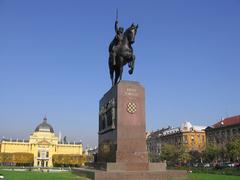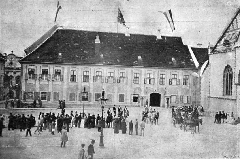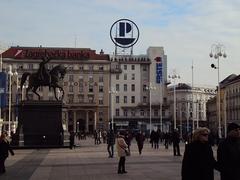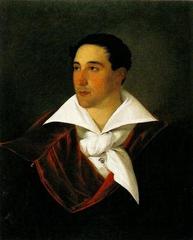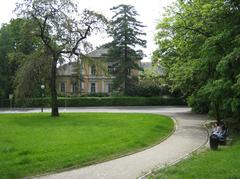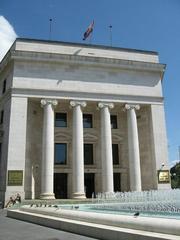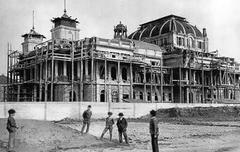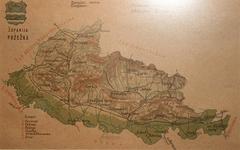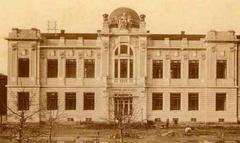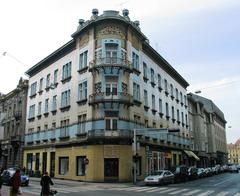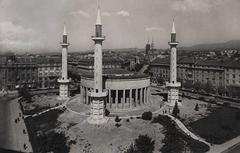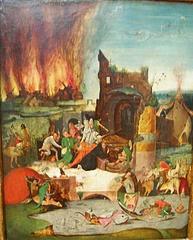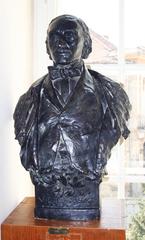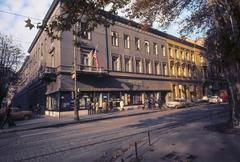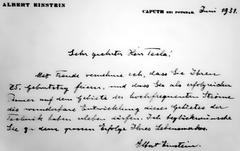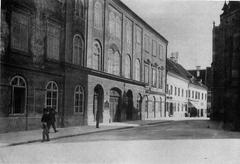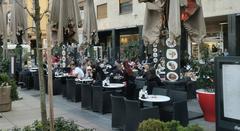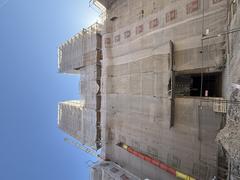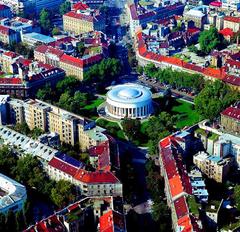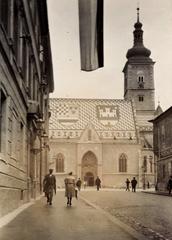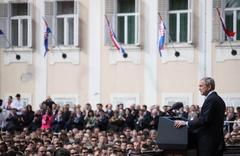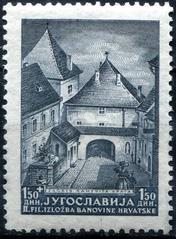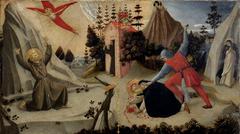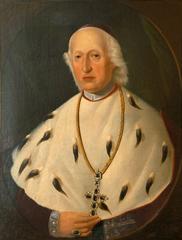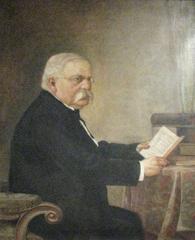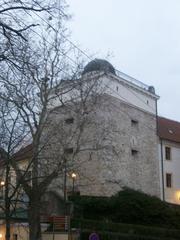Kompleks Samostana Klarisa Zagreb, Croatia: Visiting Hours, Tickets, and Historical Sites Guide
Date: 14/06/2025
Introduction
Situated in the heart of Zagreb, Croatia, the Kompleks Samostana Klarisa (Poor Clares Monastery Complex) stands as a significant cultural, historical, and spiritual landmark. Founded in the mid-17th century, this site intertwines Baroque architecture with a rich monastic tradition, playing a pivotal role in the education of young women and the spiritual life of the city. Over centuries, the monastery has endured political reforms, suppression, and transformation—most notably serving today as the Zagreb City Museum—while its spiritual legacy continues through an active Poor Clares community in Mikulići. This comprehensive guide offers detailed historical context, practical visitor information, and insights into the ongoing restoration and relevance of this treasured site (Wikipedia; Lice Grada; zajednozaklarise.com; hkm.hr).
Table of Contents
- Historical Overview
- Spiritual Life and Monastic Traditions
- Cultural Significance and Community Role
- Impact of the 2020 Earthquakes and Restoration Efforts
- Visiting Information
- Nearby Attractions and Complementary Experiences
- Visual and Virtual Resources
- Frequently Asked Questions (FAQ)
- Conclusion
1. Historical Overview
Foundation and Early Development
The Poor Clares arrived in Zagreb in 1646, founding their convent during a period of dynamic religious and urban growth. With significant support from local nobility, notably Count Gašpar Drašković, the construction began in 1647 and was completed by 1650 at the present-day site of Opatička ulica 20—now the home of the Zagreb City Museum (Wikipedia; Lice Grada).
Architectural Expansion and Urban Integration
The convent expanded between 1647 and 1670, incorporating medieval structures such as the Zakmardijeva granary and the Popov toranj (Priest’s Tower). This integration anchored the monastery within Zagreb’s medieval urban fabric. The 1851 reconstruction preserved many Baroque features while adapting the building for evolving uses (Lice Grada).
Educational and Social Role
The Klarisa Convent was a trailblazer in women’s education, hosting Croatia’s first higher girls’ school. The nuns taught Latin, Croatian (Kajkavian dialect), music, and singing, with notable students such as Judita Petronila Zrinski, daughter of Petar Zrinski (Wikipedia).
Suppression and Secularization
In 1782, Emperor Joseph II’s reforms led to the suppression of the convent and transfer of its property to the state, ending its original religious and educational roles. The associated Church of the Holy Trinity was demolished in 1823, and the gardens were later developed into private residences (Wikipedia).
Transformation into the Zagreb City Museum
The former convent buildings became the permanent home of the Zagreb City Museum in 1947. The museum’s exhibitions narrate the city’s evolution from prehistory to modern times, benefiting from archaeological excavations and careful restorations that preserved medieval artifacts and structures (Official Museum Site; 01portal.hr; Lice Grada).
Preservation of Historical Features
Key elements such as the Popov toranj and Zakmardijeva granary remain integral to the museum, offering visitors a direct connection to Zagreb’s medieval past. Ongoing conservation efforts ensure the complex’s architectural and historical integrity (Lice Grada).
The Klarisa Legacy in Modern Zagreb
The legacy of the Poor Clares survives in the very name of Opatička ulica (“Abbess Street”) and in the living tradition of contemplative life maintained by the Klarisa community in Mikulići. The museum and active monastery together safeguard and interpret Zagreb’s multifaceted history (Wikipedia).
2. Spiritual Life and Monastic Traditions
The Klarisa Monastery is a living center of contemplative spirituality. The nuns follow the Rule of St. Clare of Assisi, emphasizing poverty, simplicity, and prayer. Their cloistered lifestyle means that while the chapel is open for public worship during Mass and special religious events, the living quarters remain strictly private, fostering an atmosphere of silence and devotion (zajednozaklarise.com; Redovnistvo.hr).
Daily routines revolve around the Liturgy of the Hours, celebration of the Eucharist, and manual work, such as producing religious items and sewing vestments. The sisters’ prayers are offered for the city and those requesting intercession, positioning the monastery as a spiritual anchor in Zagreb.
3. Cultural Significance and Community Role
The Klarisa Monastery has long symbolized resilience and faith in Zagreb. The nuns’ community has endured wars, earthquakes, and political changes, most notably re-establishing itself in Mikulići in 1944 after wartime displacements. The sisters’ openness during the 2020 earthquake, when they sought public support for restoration, further integrated the monastery into the wider community and highlighted its enduring significance (ika.hkm.hr; hkm.hr).
4. Impact of the 2020 Earthquakes and Restoration Efforts
The earthquakes of March and December 2020 caused severe damage to the monastery, especially its oldest sections. Restoration is ongoing, with structural improvements, modernization, and sustainability measures—such as solar panels—being implemented. The Klarisa community relies on private donations and community support, as they are ineligible for state restoration funds (hkm.hr; bitno.net; zajednozaklarise.com).
5. Visiting Information
Visiting Hours
- Museum (Zagreb City Museum at Opatička 20):
- Tuesday to Sunday: 10:00 AM – 6:00 PM
- Closed Mondays and public holidays
- Klarisa Monastery Chapel (Mikulići):
- Public access is limited to Mass and special religious events (e.g., feast of St. Clare, August 11).
- Visitors should contact the monastery directly or check zajednozaklarise.com for current schedules.
Ticket Prices
- Zagreb City Museum:
- Adults: 30 HRK
- Students/Seniors: 15 HRK
- Children under 7: Free
- Klarisa Monastery Chapel: No entrance fee during Mass or open events; donations for restoration are encouraged.
Accessibility
- The museum complex is fully wheelchair accessible, with elevators and ramps. The Mikulići monastery is partially accessible; visitors with mobility needs should inquire ahead due to ongoing restoration.
Guided Tours and Special Events
Guided tours at the museum are available in Croatian and English by appointment. The monastery may offer guided visits during special religious occasions, subject to prior arrangement (Official Museum Site; zajednozaklarise.com).
Travel Tips
- Both locations are accessible by public transportation.
- Modest dress and respectful silence are requested, especially at the monastery chapel.
- Photography is generally allowed in the museum (without flash/tripods), but prohibited inside the monastery chapel.
6. Nearby Attractions and Complementary Experiences
Visitors to the Kompleks Samostana Klarisa can complement their trip with these attractions:
- Upper Town (Gornji Grad): St. Mark’s Church, Croatian Parliament, Museum of Broken Relationships (CleverlySmart.com)
- Zagreb Cathedral and Dolac Market
- Kvaternik Square: Local shops, markets, and cafes
Trams and buses make exploring the city convenient.
7. Visual and Virtual Resources
The official websites offer virtual tours, maps, and high-quality images with descriptive alt text for accessibility. The Audiala app provides audio guides and exclusive content for a richer visitor experience.
8. Frequently Asked Questions (FAQ)
Museum (Zagreb City Museum at Klarisa Complex)
Q: What are the visiting hours?
A: Tuesday to Sunday, 10:00 AM – 6:00 PM; closed Mondays and holidays.
Q: How much are tickets?
A: 30 HRK (adults), 15 HRK (students/seniors), free for children under 7.
Q: Is it wheelchair accessible?
A: Yes, fully accessible.
Q: Are guided tours available?
A: Yes, in Croatian and English by appointment.
Q: Can I take photos?
A: Yes, without flash or tripods.
Klarisa Monastery (Mikulići)
Q: When can I visit the chapel?
A: During Mass and special events—contact the monastery for times.
Q: Is there an entry fee?
A: No, but donations for restoration are welcome.
Q: Can I attend Mass?
A: Yes, open to the public during scheduled services.
Q: Is it accessible for people with limited mobility?
A: Partially; contact the monastery in advance.
Q: Are guided tours or visits to the cloister available?
A: No, the cloister is not open to the public.
9. Conclusion
The Kompleks Samostana Klarisa is a remarkable testament to Zagreb’s enduring spiritual, educational, and cultural legacy. From its 17th-century origins as a pioneering convent and school to its current roles as a museum and active monastic community, the complex stands as a symbol of resilience and community cohesion. Supporting its ongoing restoration, staying informed via official channels, and visiting with respect help preserve this heritage for generations to come.
For up-to-date information, virtual resources, and ways to support the monastery, visit the official sites and consider the Audiala app for enhanced exploration.
References
- Samostan Klarisa na Gornjem Gradu u Zagrebu, Wikipedia
- Kompleks Samostana Klarisa s Kaptolskom Kulom Popov Turen, Lice Grada
- Muzej Grada Zagreba službena stranica
- Samostan sv. Klare u Zagrebu započinje obnovu nakon potresa, IKA
- Pomozimo zagrebačkim klarisama obnoviti samostan stradao u zagrebačkom potresu, HKM
- Redovnistvo.hr – Institut Klarise
- Zagrebački Samostan Klarisa u Mikulićima, Zajedno za Klarise
- Uključite se u akciju obnove samostana sv. Klare u Zagrebu koji je 2020. stradao u potresu, Bitno.net
- CleverlySmart.com – Zagreb Must-See Attractions
All information is accurate as of June 14, 2025. For the latest updates, please refer to the monastery’s official website or Redovnistvo.hr.

